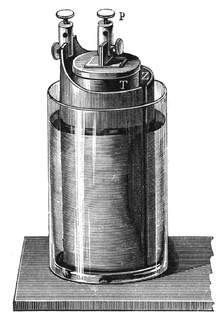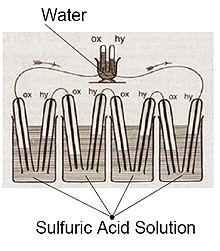William Grove
Sir William Robert Grove (born July 11, 1811 in Swansea , Wales , † August 1, 1896 in London ) was a British lawyer and physical chemist . Along with Christian Friedrich Schönbein, Grove is considered the father of the fuel cell .
Life
After Grove initially received private tuition, he graduated from Swansea Grammar School. He then attended Brasenose College , Oxford and graduated in 1832 with a Bachelor of Arts degree . He obtained his master's degree in 1835, and then he was admitted to the bar at Lincoln's Inn . However, due to his poor health, he initially did not practice this profession. Instead, he dealt with studies in the "electrical sciences," which at that time were still at an extremely unsatisfactory stage. He also became a member ("Fellow") of the Royal Society and was a co-founder of the Chemical Society , a subsidiary of the Royal Society.
In 1837 Grove married Emma Powles, with whom he had six children.
Inspired by the work of Christian Friedrich Schönbein , Grove carried out his first experiments on fuel cells at the Royal Institution of South Wales in 1839 . In the same year he invented the Grovesche element , a variant of the galvanic cell , consisting of a zinc cylinder in dilute sulfuric acid and platinum in concentrated nitric acid separated by a porous clay wall. Batteries based on this principle became common in telegraphy for the next twenty years .
Also in 1839 he demonstrated an arc lamp at the London Institution , which he operated with the cells named after him. He was then appointed professor for experimental philosophy at this institution. He held this position from 1840 to 1847. In 1841 he experimented with John Peter Gassiot in the field of daguerreotype . In 1843 he gave a lecture on the interaction of physical forces , the results of which he published in 1846 in On the Correlation of Physical Forces . In it he postulated the principle of energy conservation , a year before Hermann von Helmholtz published the work On the Conservation of Power .
In 1847 Grove received the Royal Medal from the Royal Society and served as President of the British Association for the Advancement of Science .
In 1853 Grove was appointed to the rank of Crown Attorney . In 1856 he defended the notorious poisoner William Palmer . Grove worked primarily as a patent attorney because of his technical knowledge. A lawsuit in December 1854 for infringement of the Calotype patent, an important patent in the field of photography, was considered particularly spectacular . Grove was one of the plaintiff's attorneys. Through his experience in patent law, he became a member of the Royal Commission on the Law of Patents in 1864 . As a result of his appointment as a judge at the Court of Common Pleas in 1871, the nobility took place on February 21, 1872 as a Knight Bachelor ("Sir"). In 1875 he was appointed a judge at the Supreme Court of Justice . After his retirement in 1878, he turned back to science.
Memberships and honors
In 1866 he was President of the annual meeting of the British Association for the Advancement of Science in Nottingham . From 1853 he was a corresponding member of the Accademia dei Lincei in what was then still papal Rome. After converting to the Italian National Academy, he was listed as a foreign member. In 1881 he was elected an Honorary Fellow of the Royal Society of Edinburgh .
The Grove lunar crater was named after him in 1935.
For the 150th anniversary of the development of the fuel cell , the Grove Fuel Cell Symposium was launched in 1989 in honor of Grove . The conference is held every two years and deals with new findings from the field of fuel cell technology and hydrogen production .
literature
- Ulf Bossel: The Birth of the Fuel Cell (1835-1845). Complete Correnspondence between Christian Friedrich Schoenbein and William Robert Grove . European Fuel Cell Forum. ISBN 3905592061
Individual evidence
- ↑ Galvanic battery / Grove's element . In: Meyers Konversations-Lexikon . 4th edition. Volume 6, Verlag des Bibliographisches Institut, Leipzig / Vienna 1885–1892, p. 872.
- ^ William Arthur Shaw: The Knights of England. Volume 2, Sherratt and Hughes, London 1906, p. 363.
- ^ Fellows Directory. Biographical Index: Former RSE Fellows 1783–2002. (PDF) Royal Society of Edinburgh, accessed December 12, 2019 .
Web links
- Grove Fuel Cell Symposium ( Memento September 5, 2015 in the Internet Archive )
- List of his publications ( Memento of June 8, 2011 in the Internet Archive )
- The Calotype patent lawsuit (Engl.)
| personal data | |
|---|---|
| SURNAME | Grove, William |
| ALTERNATIVE NAMES | Grove, Sir William Robert (full name) |
| BRIEF DESCRIPTION | British lawyer and scientist |
| DATE OF BIRTH | July 11, 1811 |
| PLACE OF BIRTH | Swansea , Wales |
| DATE OF DEATH | August 1, 1896 |
| Place of death | London |


